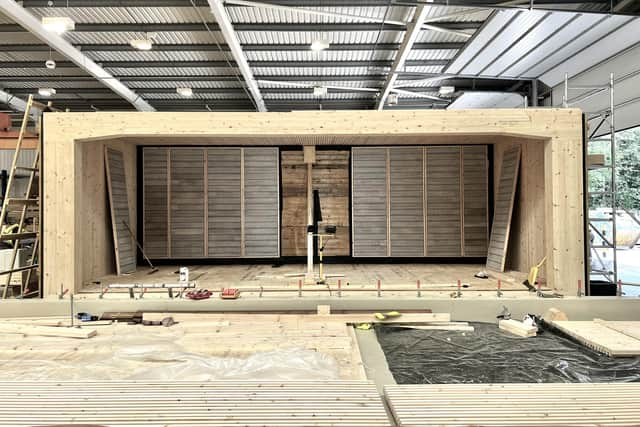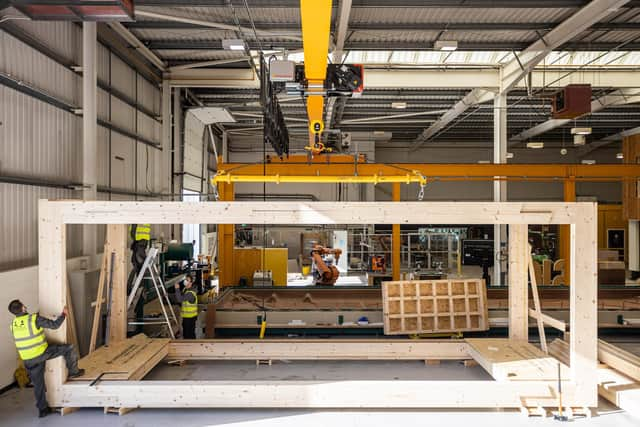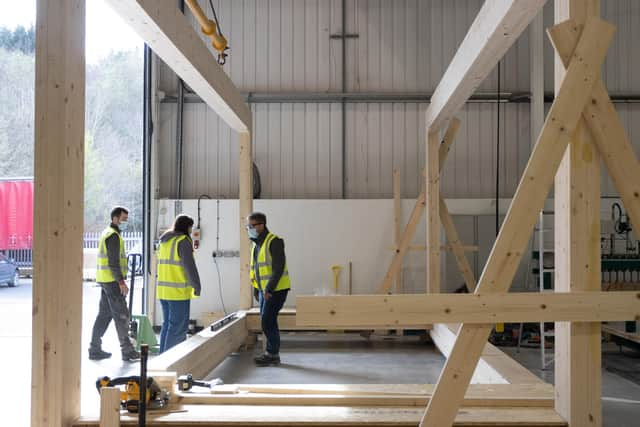Sustainable Scotland: How wooden pod kits could help turn old buildings into climate-proof workspaces of the future
The pods, which will be made from locally grown Scottish timber, can be customised to fit virtually any space and will make it possible to retrofit structures which were previously difficult and expensive to bring up to current environmental standards.
A bit like Lego or Meccano, there is built-in flexibility and the use of components manufactured offsite means the design can be applied to a range of different scenarios – from standalone structures to repurposing vacant buildings, and not only for offices.
Advertisement
Hide AdAdvertisement
Hide AdA fully functioning prototype has been constructed at a technology park near Hamilton by Built Environment – Smarter Transformation (BE-ST), formerly known as the Construction Scotland Innovation Centre, giving people a chance to see the technology for themselves.
The work forms part of the NearHome project, supported by Transport Scotland, which was formed in response to the changing working patterns of a post-Covid Scotland.
The creators say the new modular demonstration unit shows how a wooden ‘kit-of-parts’ approach can solve retrofitting problems and offer a simple route to future sustainable offices for Scottish businesses, while helping the country reach its 2045 net-zero climate target.
Using Scottish timber as a construction material will also open up new opportunities.


Lynsey Bryson, head of digital programmes at BE-ST, said: “NearHome has the potential to change how we think about the retrofit of non-domestic buildings going forward.
“We know that a one-size-fits-all approach is not going to be possible to suit the various building typologies we use in Scotland, but the modular design offers a flexible, sustainable solution that can be adapted on a case-by-case basis.
“While we were originally looking specifically at workplaces, the flexibility of the kit has shown that it could in fact be used for a range of different purposes.
“We’re pleased to now see the toolkit design come to life with the physical demonstrator and hope that it can inform and inspire decision-makers to consider it as a viable retrofit option for future projects.”


Advertisement
Hide AdAdvertisement
Hide AdThe project builds on BE-ST’s continued focus on modern methods of construction, including use of homegrown engineered timber, which is central to the NearHome design.
Environmental benefits include the use of a natural, low-carbon material that would reduce Scotland’s reliance on imports, using a kit-of-parts that can be easily deconstructed and re-used if required, as well as embracing biophilic design principles to connect occupants with nature, which has been shown to have benefits for health and wellbeing.
Initial indications from the life cycle analysis of the NearHome approach suggest using the modular, timber kit design produces just a fifth of the amount of greenhouse gas emissions involved in construction of a typical office building.


Alongside the physical demonstration unit, a free guide has also been created by ThreeSixty Architecture to enable organisations to replicate the design and adapt it to different types and sizes of buildings.
The first office spaces already commissioned using the tech are expected to be occupied later this year.
Matt Stevenson, founder of Ecosystems Technologies, said: “There are a range of ways that homegrown timber could be used more widely in construction and this retrofit design is a great example that can be easily adopted by businesses and other organisations as the built environment transitions to zero carbon.
“We are already seeing that become a reality, with interest growing and the first commercial orders for the kit-of-parts already underway.
“Scottish timber is a fantastic regenerative, low-carbon resource and there are significant opportunities to expand the use cases in the built environment through collaboration, research and digital technology.
Advertisement
Hide AdAdvertisement
Hide Ad“The NearHome project demonstrates the added advantage of a circular approach with the kit designed for reuse, meaning captured carbon can remain in the cycle for as long a period as possible.”
Minister for zero carbon buildings, active travel and tenants’ rights Patrick Harvie said: “The new unit developed by BE-ST is another important milestone for the NearHome project.
“Covid-19 led to a fundamental shift in workplace settings and working patterns.
“It also created significant challenges in terms of wellbeing, social isolation, collaboration and networking.
“We funded the NearHome project to support workplace innovation and aid Covid recovery.
“The project is helping to create safe, hygienic and connected work environments, offering greater choice, flexibility for people to work locally.
“It’s also helping to create new opportunities in Scotland’s construction industry, making better use of Scottish wood.
“Not every home is suitable for home working.
“Working from quality spaces closer to home can offer greater flexibility and work-life balance, whilst reducing car dependency and transport emissions and creating local economic opportunities – which is all part of the Scottish Government’s ambition to support the development of 20-minute neighbourhoods.”
Comments
Want to join the conversation? Please or to comment on this article.
